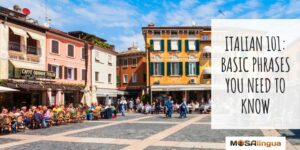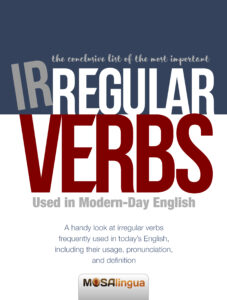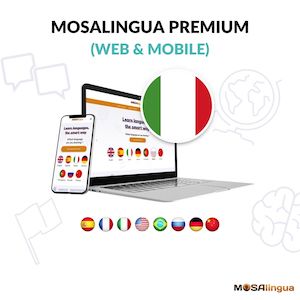Here’s the next installation in our series on frequency lists. In order to have a basic conversation in most languages, you need to know about 200 common words. Generally speaking, a vocabulary of about 1,000 words is necessary for an intermediate exchange. But if you’re a beginner, where should you start? In order to simplify your learning and start having meaningful conversations quickly, it’s important to prioritize learning words that you’ll actually use. To help you out, we’ve curated a list of the 300 most common Italian words. They’re organized into thematic lists to make them easier to memorize. Let’s have a look!

Frequency List: The 300 Most Common Italian Words for Daily Use
Simply speaking, a frequency list is a compilation of the most frequently-used words in a language. When studying a frequency list, there are a couple of things to keep in mind:
- pay attention to words that appear in fixed expressions (for example, “part” is commonly seen in “[to be] a part of”)
- it’s important to consider words in their context(s)
You’ll notice that, like English, some Italian words can have multiple meanings depending on context. Our advice is to always come up with an example sentence for each to ensure you’re using a word correctly.
You’ll find more info about the ideas behind frequency lists (and links to several more of them!) in this Wiktionary article.
Most common Italian words: Articles
Our first list is articles, because these precede any noun in Italian.
| il/lo | the (masc.) | |
| la | the (fem.) | |
| l' (fém. et masc.) | the + noun beginning with vowel (fem. and masc.) | |
| uno | a/an (masc.) | |
| una | a/an (fem.) | |
| i/gli | the (masc.) | |
| le | the (fem.) | |
| dei/degli | some (masc.) | |
| delle | some (fem.) |
Some of these words can also be personal pronouns. You’ll see some of them again in the list below. This is true for:
- lo, la = “the” (definite article), but also “him/her” (personal pronoun)
- gli = “the” (masc. pl. definite article), but also “him/them” (masc. personal pronouns)
- le = “the” (fem. pl. definite article), but also “her/them” (fem. personal pronouns)
(Lei) mangia le mele. (She eats the apples.) → Lei le mangia (She eats them.)
Pronouns and possessive adjectives
You can see that some of the words from above reappear in the two tables below. Loro, for example, can mean both “they” and “their.” This Italian word is used very often for its variety of important meanings.
Here are the different personal pronouns (I, me; you; he, she, it, him, her; we, us; they, them…):
| io (I) | mi | mi | |
| tu (you, informal) | ti | ti | |
| lui/egli/esso (he) | lo | gli | |
| lei/ella/essa (she) | la | le | |
| noi (we) | ci | ci | |
| voi (you, pl. + formal) | vi | vi | |
| essi (they, masc.) | li | gli | |
| esse (they, fem.) | le | loro | |
| loro (they, masc. + fem.) |
And here are the possessive pronouns and adjectives (my, your, his/her, mine, yours, their…):
| mio | miei | mia | mie | |
| tuo | tuoi | tua | tue | |
| suo | suoi | sua | sue | |
| nostro | nostri | nostra | nostre | |
| vostro | vostri | vostra | vostre | |
| loro | loro | loro | loro |
Demonstratives
Demonstratives designate a person or an object that is near or far from the speaker. The two most common Italian demonstratives are listed below, but they are not the only ones. There are also feminine and plural forms.
- quello – that, that one (far)
- questo – this, this one (near)
People and the human body
| persona | person |
| gente | people, person |
| uomo | man |
| donna | woman |
| famiglia | family |
| bambino | child |
| padre | father |
| madre | mother |
| figlio | son |
| figlia | daughter |
| ragazzo | boy |
| ragazza | girl |
| amico | friend |
| signore | sir |
| signora | madame |
| corpo | body |
| faccia | face |
| viso | face |
| testa | head |
| occhio | eye |
| piede | foot |
| mano | hand |
| voca | voice |
| nome | name |
World and environment
| mondo | world |
| paese | country (nation) |
| stato | state |
| campagna | country (rural area) |
| città | city |
| strada | street |
| via | street, way |
| casa | house |
| porta | door |
| stanza | room |
| camera | bedroom |
| luce | light |
| aria | air |
| acqua | water |
| mare | sea |
| pesce | fish |
| carne | meat |
| uccello | bird |
| uovo | egg |
| pelle | skin |
| frutta | fruit |
| terra | earth |
| sale | salt |
Time
| tempo | time |
| anno | year |
| anni | years |
| mese | month |
| settimana | week |
| giorno | day |
| mattina | morning |
| sera | evening |
| notte | night |
| ora | hour |
| oggi | today |
| ieri | yesterday |
| domani | tomorrow |
| momento | moment |
| volta | time, instance |
Other nouns
There are several other nouns that come up frequently in conversation. You’ll be likely to use these as a beginner:
| amore | love |
| caso, casi | case, affair |
| capo | boss |
| cosa | thing |
| cuore | heart |
| accanto | beside |
| diritto | straight, law |
| fatto | fact |
| modo | manner |
| forza | strength |
| governo | government |
| guerra | war |
| storia | history |
| lettera | letter |
| legge | law |
| parola | word |
| musica | music |
| opera | opera, work of art |
| parte | part |
| punto | point |
| potere | power |
| ragione | reason |
| senso | sensation, impression |
| lavoro | work |
| vita | life |
Italian words: Most common verbs
And here are some of the most useful verbs to know. We’ve provided the infinitive form and the first-person singular conjugation (I …). As you get used to seeing these verbs and and internalize their meanings, don’t hesitate to start creating conjugation tables. We recommend that you start with the first three singular conjugations (I, you, he/she), because these are the most common.
| avere | ho | to have |
| essere | sono | to be |
| potere | posso | to be able to |
| volere | voglio | to want |
| vorrei | I would likeÉ | |
| dovere | devo | must (obligation) |
| andare | vado | to go |
| va | [he] goes / [he] must | |
| bisognare | bisogno | to need |
| piacere | piace | to like |
| amare | amo | to love |
| chiamare | chiamo | to call |
| arrivare | arrivo | to arrive |
| cantare | canto | to sing |
| cercare | cerco | to search |
| cominciare | comincio | to begin |
| capire | capisco | to understand |
| conoscere | conosco | to know (to be familiar with a person or place) |
| chiedere | chiedo | to ask |
| diventare | divento | to become |
| dire | dico | to say |
| dare | do | to give |
| fare | faccio | to make / to do |
| finire | finisco | to finish |
| lasciare | lascio | to leave |
| mangiare | mangio | to eat |
| mettere | metto | to put [on] |
| ottenere | ottengo | to obtain |
| parere | paio | to appear / to seem |
| parlare | parlo | to speak |
| passare | passo | to pass / to spend |
| pensare | penso | to think |
| portare | porto | to bring / to wear |
| prendere | prendo | to take |
| guardare | guardo | to watch |
| rispondere | rispondo | to respond |
| rimanere | rimango | to stay / to remain |
| stare | sto | to stay |
| sapere | so | to know (a fact) |
| sembrare | sembro | to seem |
| sentire | sento | to feel / to hear |
| seguire | seguo | to follow |
| tenere | tengo | to hold |
| trovare | trovo | to find |
| venire | vengo | to come |
| vivere | vivo | to live |
| vedere | vedo | to see |
Numbers
| uno | one |
| due | two |
| tre | three |
| quattro | four |
| cinque | five |
| cento | hundred |
| mille | thousand |
| primo | first |
| secondo | second |
| terzo | third |
| mezzo | half |
Adjectives
Adjectives are used to modify nouns. Unlike in English, adjectives in Italian must match the gender and number of the nouns they describe. A feminine plural noun means you must use the feminine plural form of the adjective. So make sure you pay attention to each of their different forms. For simplicity, this list only includes masculine singular forms.
| alto | high |
| aperto | open |
| bene | well |
| bello | beautiful |
| buon | good |
| caro | expensive, cherished |
| cattivo | bad |
| certo | sure, certain |
| giovane | young |
| grande | large |
| italiano | Italian |
| libera | free |
| lungo | long |
| maggiore | major, principle |
| meglio | better |
| nero | black |
| nuovo | new |
| piccolo | small |
| povero | poor |
| tutto | all |
| ultimo | last |
| vecchio | old |
| vero | true |
Adverbs
Adverbs typically add additional information to enrich an idea.
| alcuni | some, certain |
| alcuno | none, without |
| altro | other |
| ancore | still |
| destra | right (direction) |
| diverso | several |
| dritto | right (direction) |
| dopo | after |
| forse | maybe |
| già | already |
| lì | there |
| lontano | far |
| meno | less |
| molto | many |
| nessuno | no one |
| no | no |
| ogni | each |
| pieno | full |
| più | more |
| poco | little |
| presto | soon |
| proprio | really, own [one's self] |
| qualche | some, certain |
| quasi | almost |
| qui/qua | here |
| sinistra | left (direction) |
| solo | only, alone |
| spesso | often |
| stesso | same |
| tale | like, as |
| tanto | much, many |
| troppo | too |
| vicino | near |
Prepositions
| a | to |
| al | to |
| con | with |
| di | from |
| da | to, from, since |
| fino | until |
| in | in |
| nel | in |
| per | by, for |
| senza | without |
| sotto | under |
| su | on |
| tra | between |
Question words
In Italian, most of these words can also be used in affirmative phrases. But do be aware that some can have multiple meanings, such as perché which can mean both “why?” and “because.”
| quanto | how many |
| quando | when |
| come | how like |
| dove | where |
| chi | who |
| che | that, which |
| cosa | what |
| quale | which |
| perché | why because |
Other common Italian words: Conjunctions, connectors, etc.
These other common words will be useful for adding additional color and details to your expression.
| ma | but |
| o | or |
| e | and |
| dunque | so |
| quindi | so |
| ne | neither |
| se | if |
| allora | so, then |
| difatti | in fact, indeed |
| anche | also |
| pure | also, too, even, although |
| pero | but |
| tuttavia | however, nevertheless |
| mentre | while |
| percio | therefore |
| prima | firstly |
| inoltre | additionally |
| poi | then, furthermore |
| non | not (negation) |
| si | one, self (reflexive) |
Important Italian words: Polite phrases
There are about 85 million Italian speakers around the world, so it’s definitely a good language to know. Italian culture is rich and fascinating – if you’re planning a trip to experience it for yourself, make sure you learn at least these indispensable polite phrases!
- Buongiorno – Hello
- Arrivederci – Goodbye
- Ciao – Hi
- Grazie (mille) – Thank you (very much)
- Per favore – Please
- Scusi – Excuse me / Sorry
- Mi chiamo… – My name is…
- Piacere – It’s a pleasure [to meet you].
You can also check out this article to learn a broader range of basic Italian phrases that will help you communicate with native speakers during a trip.
Communicating with gestures
And don’t forget that Italians talk with their hands, too! They have quite a reputation for using expressive gestures while speaking. Hand gestures can make up as much as 60% of non-verbal communication. So don’t hesitate to use your body to help get your point across!
To finish up this article on the most common Italian words, here’s a quick saying that sums up all you need to know about la dolce via (the good life) in Italy: Mangia bene, ridi spesso, ama molto. (Eat well, laugh often, love much.)
Go further
If you found these Italian frequency lists interesting, you might also enjoy exploring some of the lists we’ve compiled in other languages, as well:
Related posts:
Start improving your Italian today
Good news: we can help!
More good news: you can get started for free! With your free trial, you can test drive the most effective method for learning Italian for the next 15 days!
Vocabulary flashcards, videos with subtitles, audiobooks, articles adapted to your level – with MosaLingua Premium (Web & Mobile), you’ll have access to all this and more. Get started right now. It’s free—and risk-free—to try!





Comments